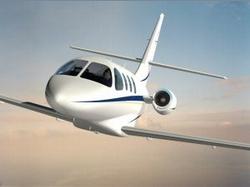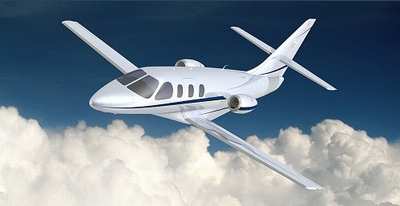An Interesting Day To Announce This, Eh?
 Safire Aircraft, the Florida based manufacturer of
a hoped-for new generation low cost Safire Jet, has selected a new
version of the Williams International FJ33 turbofan engine as the
power plant for the new Safire Personal Jet. Each engine is
controlled via dual-channel FADECs and will provide 1,100 pounds of
thrust at 72°F sea level standard conditions. The FJ33, which
is on schedule to achieve FAA certification in December 2003, will
have a 3-year/1500 hour warranty.
Safire Aircraft, the Florida based manufacturer of
a hoped-for new generation low cost Safire Jet, has selected a new
version of the Williams International FJ33 turbofan engine as the
power plant for the new Safire Personal Jet. Each engine is
controlled via dual-channel FADECs and will provide 1,100 pounds of
thrust at 72°F sea level standard conditions. The FJ33, which
is on schedule to achieve FAA certification in December 2003, will
have a 3-year/1500 hour warranty.
 “The FJ33 family is based in a large part on
our highly successful FJ44 plus an infusion of ongoing component
technology improvements” says Gregg Williams, President and
COO of Williams International. “The FJ33 will continue and
extend the highly successful performance and reliability track
record of the FJ44 series for the new light entry level jet market
segment.”
“The FJ33 family is based in a large part on
our highly successful FJ44 plus an infusion of ongoing component
technology improvements” says Gregg Williams, President and
COO of Williams International. “The FJ33 will continue and
extend the highly successful performance and reliability track
record of the FJ44 series for the new light entry level jet market
segment.”
In making the announcement, Miguel de Miranda Correa, lead
investor of the Swiss syndicate funding the program, says,
“We talked with Safire on many occasions during the past few
years. I have come to be very impressed with their intent to make
the Safire Jet the safest, most dependable and reliable of its
class. Their desire to provide a “best value concept”
is reflected throughout their design and systems. Very clearly the
FJ33 engine became an excellent match to this design.“
Safire is making some pretty "aggressive" claims for the
here-to-fore much-delayed development program, from here on out.
Safire says the first flight test aircraft is planned to
fly in Q1 2004. FAA certification of the Safire Jet is planned for
December 2005. Customer deliveries are scheduled to begin in Q1
2006.
 “Immediate availability of FJ33 engines for
our aircraft flight test and certification programs coupled with
anticipated FAA engine certification in December 2003 provides
Safire with a significant first-to-market advantage” says
Camilo Salomon, CEO of Safire Aircraft.
“Immediate availability of FJ33 engines for
our aircraft flight test and certification programs coupled with
anticipated FAA engine certification in December 2003 provides
Safire with a significant first-to-market advantage” says
Camilo Salomon, CEO of Safire Aircraft.
Michael Margaritoff, founder of Safire Aircraft, said
“Over the years Safire has talked with literally every jet
engine manufacturer, including some organizations that had
extensive design experience but had never before actually produced
an engine. In looking at aviation history it became very clear that
any commercial program that attempted to combine a totally new
airframe design with an advanced technology, but unproven engine,
hardly ever succeeded and virtually never became successful. The
inevitable surprises usually lead to major setbacks and eventually
unsuccessful endeavors.

Because the FJ33 achieves its performance parameters
through a conservative derivative approach from Williams
International’s exceptional FJ44, we are convinced it will
provide our owners with the level of operational safety,
dependability, dispatch reliability, and predictable operating
costs we want to incorporate into our Safire Personal Jet right
from the outset of deliveries.”
 ANN's Daily Aero-Linx (05.02.24)
ANN's Daily Aero-Linx (05.02.24) ANN's Daily Aero-Term (05.02.24): Touchdown Zone Lighting
ANN's Daily Aero-Term (05.02.24): Touchdown Zone Lighting Aero-News: Quote of the Day (05.02.24)
Aero-News: Quote of the Day (05.02.24) ANN FAQ: Contributing To Aero-TV
ANN FAQ: Contributing To Aero-TV NTSB Final Report: Cirrus Design Corp SR20
NTSB Final Report: Cirrus Design Corp SR20






